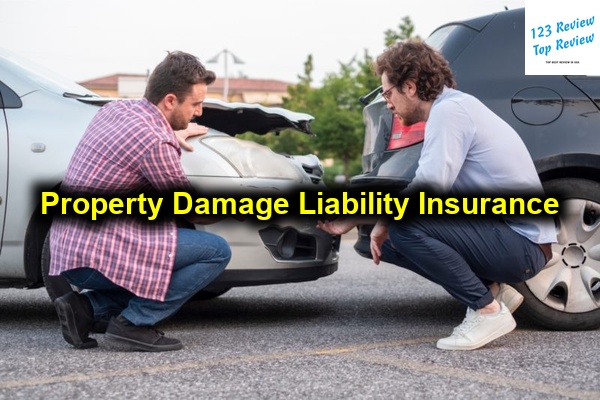Property Damage Liability Insurance is particularly crucial in vehicular accidents, where it covers the cost of repairing or replacing damaged property, which can include anything from other vehicles to buildings, fences, or even public infrastructure like street signs or lamp posts.
The primary purpose of property damage liability insurance is to ensure that you, as the at-fault party in an accident, can fulfill your financial obligations without incurring significant out-of-pocket expenses. Without this coverage, you could be liable for thousands of dollars in damages, potentially leading to financial ruin.

In this article, 123 Review will delve deeper into the various facets of property damage liability insurance, including the types of coverage available, factors influencing costs, state requirements, and tips on choosing the right provider.
Types of Coverage Offered
Property damage liability insurance typically comes in two forms: per-accident coverage and per-claim coverage.
- Per-Accident Coverage: This type of coverage limits the total amount the insurance company will pay for property damage in a single accident. For example, if your policy has a per-accident limit of $50,000 and you cause an accident that results in $60,000 worth of damage, you would be responsible for paying the remaining $10,000 out of pocket. Per-accident coverage is designed to provide comprehensive protection for all damages resulting from one incident, regardless of how many parties are involved.
- Per-Claim Coverage: This type of coverage sets a limit on the amount the insurer will pay for each claim filed against your policy. For instance, if you cause damage to two separate properties in one accident, and your policy has a per-claim limit of $25,000, the insurer will pay up to $25,000 for each claim, but no more. It is crucial to understand the distinctions between these coverage types when selecting a policy, as they directly impact your financial liability in the event of an accident.
Importance of Coverage Limits
Choosing the right coverage limits is one of the most important decisions you will make when purchasing property damage liability insurance. Coverage limits determine the maximum amount your insurance company will pay in the event of a claim. If the damages exceed your coverage limits, you will be personally responsible for paying the difference.
For example, if you have a coverage limit of $25,000 and cause $40,000 in damages, you will need to pay the remaining $15,000 out of your own pocket. This can be financially devastating, especially if you are unable to cover the cost.
Higher coverage limits offer greater protection but come with higher premiums. It’s essential to strike a balance between adequate protection and affordability. Many experts recommend opting for higher coverage limits to protect against the possibility of severe financial loss. It’s also worth noting that the minimum coverage required by your state may not be sufficient to cover all potential damages, so it’s wise to consider purchasing more than the minimum required amount.
Comparing Policy Features
When comparing property damage liability insurance policies, it’s essential to consider various features beyond just the coverage limits. While the limits are crucial, other policy features can significantly impact your overall satisfaction and the effectiveness of your coverage.
- Deductibles: Although deductibles are more commonly associated with collision and comprehensive coverage, understanding the concept is still important when considering overall auto insurance policies. A deductible is the amount you must pay out of pocket before your insurance kicks in. Higher deductibles generally lower your premiums, but they increase your out-of-pocket costs in the event of a claim.
- Additional Coverages: Some insurers offer additional coverages that can enhance your protection, such as roadside assistance, rental car reimbursement, or gap insurance. While these may not be directly related to property damage liability, they can provide added peace of mind and convenience in the event of an accident.
- Policy Exclusions: It’s essential to understand what is not covered by your policy. Some policies may have exclusions for certain types of property, such as luxury vehicles or commercial property, which could leave you exposed if an accident occurs.
- Customer Service and Claims Process: The ease and efficiency of the claims process can vary significantly between insurers. Researching customer reviews and ratings can provide insight into how well a company handles claims, which can be a critical factor when you need to file one.
Costs and Premiums
Factors Affecting Insurance Costs
The cost of property damage liability insurance can vary widely based on several factors, many of which are specific to you as a driver. Understanding these factors can help you make informed decisions about your coverage and find ways to manage your premiums effectively.
- Driving History: Your driving record is one of the most significant factors influencing your insurance costs. Drivers with a history of accidents or traffic violations are considered higher risk and, therefore, face higher premiums. On the other hand, a clean driving record can help you secure lower rates.
- Location: Where you live can have a substantial impact on your insurance costs. Urban areas, where traffic congestion and accident rates are typically higher, tend to have higher premiums compared to rural areas. Additionally, states with higher minimum coverage requirements may also have higher insurance costs.
- Vehicle Type: The make, model, and age of your vehicle can affect your premium. More expensive vehicles, or those with higher repair costs, generally lead to higher premiums. Conversely, older vehicles or those with lower market value may result in lower premiums.
- Coverage Limits: As mentioned earlier, higher coverage limits generally lead to higher premiums. However, while it may be tempting to opt for lower limits to save on costs, this can be a risky strategy if you end up causing significant damage.
- Credit Score: In many states, insurers consider your credit score when determining your premiums. A higher credit score often results in lower premiums, as insurers believe that individuals with good credit are less likely to file claims.
- Deductibles: While deductibles are not typically associated with property damage liability coverage, they play a role in your overall auto insurance policy. Choosing a higher deductible for other types of coverage, like collision or comprehensive, can lower your overall premium.
Average Cost of Property Damage Liability Insurance
The average cost of property damage liability insurance varies depending on several factors, including your location, driving history, and the coverage limits you choose. However, as a general guideline, drivers can expect to pay between $200 and $500 annually for this type of coverage.
For example, drivers in states with lower minimum coverage requirements may pay closer to the $200 mark, while those in states with higher requirements or higher accident rates may see premiums closer to $500 or more. Additionally, drivers with a history of accidents or those who opt for higher coverage limits can expect to pay more.
It’s important to remember that these are average figures, and your actual cost could be higher or lower depending on your specific circumstances. To get an accurate estimate, it’s best to request quotes from multiple insurers based on your personal information and coverage needs.
How to Save on Premiums
While property damage liability insurance is a necessary expense, there are several strategies you can employ to reduce your premiums and save money without sacrificing coverage.
- Shop Around: One of the most effective ways to save on insurance premiums is to compare quotes from multiple insurers. Different companies assess risk differently, so shopping around can help you find the best rate for your situation.
- Bundle Policies: Many insurance companies offer discounts if you bundle multiple policies together, such as combining your auto and homeowners insurance. This can result in significant savings.
- Maintain a Clean Driving Record: A clean driving record is one of the best ways to keep your premiums low. Avoiding accidents and traffic violations can help you maintain lower rates over time.
- Increase Your Deductible: If you have collision or comprehensive coverage, increasing your deductible can lower your overall premium. Just be sure that you can afford to pay the higher deductible if you need to file a claim.
- Take Advantage of Discounts: Many insurers offer various discounts that can help reduce your premiums. These may include discounts for safe driving, having anti-theft devices installed in your vehicle, being a good student, or being a member of certain organizations.
- Consider Usage-Based Insurance: Some insurers offer usage-based insurance programs, where your premium is based on your driving habits. If you are a safe driver or don’t drive frequently, this could be a cost-effective option.
State Requirements and Legal Aspects
Minimum Coverage Requirements by State
Each state in the U.S. has its own minimum coverage requirements for property damage liability insurance. These requirements are set by state law and vary widely. Some states require only minimal coverage, while others have more stringent requirements to ensure that drivers can cover significant damages.
For example, California mandates a minimum of $5,000 in property damage liability coverage, which is relatively low compared to other states. In contrast, states like Texas and Florida require a minimum of $25,000, reflecting the higher potential costs of property damage in those regions.
It’s important to note that these minimum requirements are just that—minimums. In many cases, the state-mandated minimum may not be sufficient to cover the full cost of damages in a serious accident. Therefore, many experts recommend purchasing more than the minimum required coverage to protect yourself from potential financial liability.
Consequences of Not Having Coverage
Failing to carry the required property damage liability insurance can have serious consequences. If you are caught driving without the necessary coverage, you may face fines, penalties, and even the suspension of your driver’s license. In some states, repeat offenders may also face jail time.
Moreover, if you are involved in an accident without insurance, you could be held personally liable for all damages. This means that you would need to pay for the repairs or replacement of the damaged property out of your own pocket, which could result in significant financial hardship.
In addition to the immediate financial and legal consequences, not having coverage can also lead to long-term repercussions. For example, being caught without insurance can result in higher premiums when you do obtain coverage, as insurers will view you as a higher risk. It can also lead to a suspended or revoked license, making it difficult to get to work or meet other obligations.
How to Check Your State’s Requirements
Understanding your state’s specific requirements for property damage liability insurance is crucial to ensure that you are in compliance with the law. There are several ways to check your state’s requirements:
- State Department of Motor Vehicles (DMV) Website: Most states provide detailed information about minimum insurance requirements on their DMV websites. This is often the most direct and accurate source of information.
- Consult with Your Insurance Provider: Insurance agents are well-versed in state regulations and can provide guidance on the minimum coverage you need. They can also help you determine if you should purchase additional coverage beyond the state minimums.
- State Insurance Department: Each state has an insurance department that regulates and oversees insurance companies and policies. These departments often provide resources and information on state requirements and can answer any questions you may have.
- Review Your Current Policy: If you already have auto insurance, review your policy documents to see what coverage you currently have. Compare this with your state’s minimum requirements to ensure you are adequately covered.
Filing Claims
Steps to File a Property Damage Liability Claim
If you are involved in an accident and need to file a property damage liability claim, it’s essential to follow the correct procedures to ensure a smooth and successful process. Here are the typical steps involved in filing a claim:
- Report the Accident: As soon as the accident occurs, report it to your insurance company. Most insurers have 24/7 hotlines or mobile apps that make it easy to file a claim immediately. Prompt reporting is crucial, as delays can complicate the process and may even result in claim denial.
- Document the Damage: Take photos and gather as much evidence as possible at the scene of the accident. This includes photographing the damage to all vehicles and any other property involved, as well as obtaining witness statements and police reports. The more documentation you have, the stronger your claim will be.
- Submit Necessary Information: Your insurance company will require specific documents to process your claim. This typically includes the police report, repair estimates, and any other relevant information, such as witness contact details. Ensure that you provide all requested information promptly to avoid delays.
- Work with the Adjuster: Once your claim is filed, the insurance company will assign an adjuster to assess the damage and determine the payout amount. Be cooperative and provide any additional information the adjuster may need. The adjuster’s assessment will play a crucial role in determining the final settlement.
- Receive Compensation: After the adjuster has completed their assessment, the insurance company will issue a payment to cover the repair or replacement costs. Depending on your policy and the nature of the damage, this payment may go directly to the repair shop, or you may receive it directly to pay for the repairs yourself.
Common Pitfalls in Claim Filing
Filing a property damage liability claim can be a straightforward process, but there are common pitfalls that can lead to complications or even claim denial. Being aware of these pitfalls can help you avoid them and ensure a successful claim.
- Delays in Reporting: One of the most common mistakes is delaying the reporting of an accident to the insurance company. Some policies have strict time limits for reporting claims, and failing to do so within that window can result in denial.
- Incomplete Documentation: Inadequate or missing documentation can slow down the claims process and may even lead to a lower settlement. Always provide complete and accurate information, including photos, repair estimates, and witness statements.
- Underestimating Damage: It’s easy to underestimate the extent of damage, especially if it appears minor at first glance. However, hidden damage can be costly, so it’s important to have a thorough assessment by a professional before accepting a settlement.
- Accepting the First Offer: Insurance companies may offer a quick settlement to close the case, but this initial offer may not always reflect the full extent of the damage. Don’t hesitate to negotiate or seek a second opinion if you believe the offer is too low.
Tips for Successful Claims
To maximize the chances of a successful property damage liability claim, consider the following tips:
- Be Prompt: Report the accident and file your claim as soon as possible. Prompt action demonstrates your seriousness and can help expedite the process.
- Keep Detailed Records: Maintain thorough documentation of the accident, including photos, repair estimates, and any correspondence with your insurance company. This will serve as valuable evidence if there are disputes or delays.
- Follow Up Regularly: Stay in contact with your insurance company and follow up regularly on the status of your claim. This ensures that your claim is being processed and allows you to address any issues that may arise promptly.
- Consider Professional Help: If your claim is complex or if you’re facing difficulties with your insurer, consider hiring a public adjuster or an attorney specializing in insurance claims. They can help you navigate the process and ensure you receive fair compensation.
Choosing the Right Provider
Top Insurance Companies for Property Damage Liability
Selecting the right insurance provider is crucial to ensuring you receive the best possible coverage and service. When choosing a provider for property damage liability insurance, consider companies with strong reputations, competitive pricing, and a proven track record of customer satisfaction. Here are some of the top insurance companies known for their property damage liability coverage:
- State Farm: State Farm is one of the largest and most well-known insurance companies in the U.S. It is renowned for its reliable coverage, extensive agent network, and excellent customer service. State Farm offers a wide range of auto insurance products, including property damage liability, with customizable coverage options to meet individual needs.
- GEICO: GEICO is famous for its affordable premiums and user-friendly online platform. The company offers various discounts, including those for good drivers, military members, and federal employees, making it a cost-effective choice for many drivers. GEICO is also known for its efficient claims process and strong customer support.
- Progressive: Progressive is another major player in the auto insurance market, known for its innovative approach to coverage options and competitive pricing. Progressive offers customizable policies with a variety of add-ons, including roadside assistance and rental car reimbursement, which can enhance your property damage liability coverage.
- Allstate: Allstate is well-regarded for its comprehensive coverage options and strong customer service. The company offers a range of discounts and policy features, including accident forgiveness and new car replacement, which can provide additional peace of mind. Allstate’s network of local agents ensures personalized service and support.
- Liberty Mutual: Liberty Mutual offers flexible coverage options and a range of discounts, making it a popular choice for drivers seeking affordable and comprehensive insurance. The company is known for its customer-friendly approach, including features like the Liberty Mutual app, which allows for easy policy management and claims filing.
Customer Reviews and Ratings
When selecting an insurance provider, it’s essential to consider customer reviews and ratings. These provide valuable insights into how a company handles claims, customer service, and overall satisfaction. Here are some key sources to consider:
- J.D. Power: J.D. Power conducts annual surveys of auto insurance customers, providing detailed ratings and reviews of insurance companies based on factors like customer satisfaction, claims handling, and pricing. Companies that receive high ratings from J.D. Power are generally well-regarded in the industry.
- Better Business Bureau (BBB): The BBB provides ratings and reviews of businesses, including insurance companies. A high BBB rating indicates that the company has a strong track record of resolving customer complaints and providing good service.
- Consumer Reports: Consumer Reports offers detailed reviews and ratings of auto insurance companies, based on surveys of policyholders. The organization evaluates factors like claims satisfaction, price satisfaction, and overall customer experience.
- Online Reviews: Websites like Yelp, Google Reviews, and Trustpilot feature customer reviews of insurance companies. While these reviews can be subjective, they can provide a sense of common issues or strengths associated with a particular insurer.
Comparing Providers Based on Coverage and Cost
When comparing insurance providers, it’s important to look beyond just the cost of premiums. While affordability is a key consideration, it’s equally important to ensure that the coverage offered meets your needs. Here are some factors to consider when comparing providers:
- Coverage Options: Review the coverage options offered by each provider, including the availability of additional coverages like roadside assistance, rental car reimbursement, and gap insurance. Ensure that the policy you choose provides comprehensive protection.
- Deductibles: Consider the deductibles associated with each policy. While property damage liability typically doesn’t have a deductible, other coverages like collision or comprehensive may. Ensure that the deductibles are affordable and align with your budget.
- Customer Service: Evaluate the quality of customer service offered by each provider. Look for companies with strong customer reviews, high ratings from organizations like J.D. Power, and a reputation for efficient claims handling.
- Discounts: Many insurance companies offer discounts that can significantly reduce your premiums. Compare the discounts offered by each provider and determine which ones you qualify for. Common discounts include those for safe driving, bundling policies, and having certain safety features in your vehicle.
- Claims Process: The ease and efficiency of the claims process can vary between providers. Research how each company handles claims, including the average time for processing and customer satisfaction with the process. A smooth claims experience can make a significant difference if you ever need to file a claim.
Additional Considerations
The Role of Collision and Comprehensive Coverage
While property damage liability insurance covers damage you cause to other people’s property, collision and comprehensive coverage protect your own vehicle. Understanding the role of these coverages is important for a well-rounded auto insurance policy.
- Collision Coverage: This coverage pays for damage to your vehicle resulting from a collision with another vehicle or object, regardless of who is at fault. For example, if you hit another car or a tree, collision coverage would pay for the repairs to your vehicle.
- Comprehensive Coverage: Comprehensive coverage protects your vehicle against damage from non-collision events, such as theft, vandalism, natural disasters, or hitting an animal. It covers a wide range of potential risks, providing peace of mind for unexpected events.
While collision and comprehensive coverage are optional in many states, they are often required if you have a car loan or lease. Even if not required, these coverages are worth considering, especially if you drive a newer or more valuable vehicle. They ensure that your investment is protected, even if you’re involved in an accident or experience damage from other causes.
Understanding Deductibles in Liability Insurance
While property damage liability insurance typically does not involve deductibles, it’s important to understand how deductibles work in other aspects of auto insurance, such as collision and comprehensive coverage. A deductible is the amount you pay out of pocket before your insurance coverage kicks in.
For example, if you have a $500 deductible and your vehicle sustains $2,000 in damage, you would pay the first $500, and your insurance would cover the remaining $1,500. Choosing a higher deductible can lower your premium, but it also means you’ll pay more out of pocket in the event of a claim.
When selecting your deductible, consider your financial situation and how much you can afford to pay out of pocket in the event of an accident. A higher deductible may be a good option if you want to lower your premium, but make sure it’s an amount you can comfortably pay if needed.
Enhancing Protection with Additional Policies
In addition to standard auto insurance coverages, there are several additional policies and endorsements that can enhance your protection:
- Umbrella Insurance: Umbrella insurance provides additional liability coverage beyond the limits of your auto insurance policy. It’s designed to protect you from major claims and lawsuits, offering an extra layer of security for your assets.
- Uninsured/Underinsured Motorist Coverage: This coverage protects you if you’re involved in an accident with a driver who doesn’t have insurance or whose insurance is insufficient to cover the damages. It ensures that you’re not left with significant out-of-pocket expenses if the other driver is at fault.
- Gap Insurance: Gap insurance covers the difference between the actual cash value of your vehicle and the amount you owe on your car loan or lease. It’s particularly useful if you have a new or financed vehicle, as the value of a new car can depreciate quickly, leaving you with a “gap” in coverage.
- Roadside Assistance: This coverage provides help if your vehicle breaks down, runs out of gas, or needs a tow. It can be a valuable addition to your auto insurance policy, especially if you frequently drive long distances or in remote areas.
- Rental Car Reimbursement: If your vehicle is in the shop for repairs after an accident, rental car reimbursement coverage pays for the cost of a rental car. This coverage ensures that you’re not left without transportation while your vehicle is being repaired.
By considering these additional policies and endorsements, you can create a comprehensive auto insurance plan that provides robust protection for both you and your vehicle.
In conclusion, property damage liability insurance is a critical component of your auto insurance policy. It protects you from financial liability if you cause damage to someone else’s property, ensuring that you can cover the costs of repairs or replacement without incurring significant out-of-pocket expenses. By understanding the types of coverage available, factors influencing costs, state requirements, and the claims process, you can make informed decisions and select the right policy to meet your needs. Additionally, exploring additional coverages and endorsements can enhance your protection, providing peace of mind on the road.





